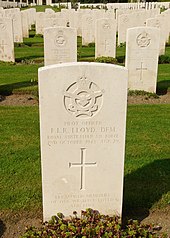Durnbach War Cemetery
The Durnbach War Cemetery and the Durnbach Cremation Memorial is a war cemetery of the Commonwealth War Graves Commission (CWGC) on the federal highway 472 in the district of Dürnbach in the municipality of Gmund am Tegernsee in Upper Bavaria .
history
Shortly after the Second World War , the CWGC decided to build a central war cemetery in Dürnbach. Most of those buried there belonged to the Royal Air Force and were transferred to Dürnbach from existing individual or group graves from Bavaria , Württemberg , Austria , Hesse and Thuringia . Some of the dead are members of the forces of the British Empire who were killed trying to escape from German prisoner of war camps .
Occupancy
In the end, 2960 Commonwealth soldiers found their final resting place in the military cemetery, 93 of which could not be identified . Tombs were also erected for another 30 fallen from other nations , mostly Poles .
On a board in the entrance portal of the military cemetery it says (in English and German):
“On this war cemetery, 2,960 fallen soldiers from the Second World War, mainly members of the Air Force, were buried. Broken down by nationality, there are 2,020 British, 484 Canadians, 281 Australians, 70 New Zealanders, 30 South Africans, 41 Indians, 3 East Africans, 1 French, 1 Norwegian, 20 Poles, 1 Russian, 4 Americans and 4 of unknown nationality.
There are also memorials to 5 British and 1 South African military personnel who were buried elsewhere, but whose graves have been lost, and a memorial to 23 Indian soldiers whose bodies were cremated. "
Durnbach Cremation Memorial
A memorial stone (Durnbach Cremation Memorial) was erected in the area in which mainly Indian war victims were buried , commemorating these corpses who were cremated in accordance with their religious traditions .
layout
This military cemetery was unobtrusively integrated into the landscape by the architect Philip Hepworth . Like all CWGC cemeteries, which are always built according to the same scheme, this one is also noticeable due to its symmetrical and exact arrangement.
The line of sight is formed by the "Cross of Sacrifice" ( sacrificial cross with sword on top ) and the "Stone of Remembrance" ( altar stone ) and closed in the background by two small towers in the Moorish style. On the altar stone is written “Their name liveth for evermore”.
The fence is kept low and thus offers a wide panoramic view of the cemetery grounds . Two towers in the Moorish style are also built on both sides of the entrance gate.
The tombstones are aligned parallel to each other and are provided with the troop coat of arms , name and rank , date of death, religious affiliation and a motto (if desired and suggested by the relatives). There are no groupings according to origin and rank to symbolize "equality in death" . Most of the stones come from Great Britain and were labeled in France. Some of the stones came from Italy. Many tombstones have already been renovated or replaced with new ones. In the entrance portal there is a list with the names of the deceased and the grave number. The rows of graves are numbered.
The planting chosen was a continuous, level lawn without separating paths with low bushes. The gravestones are bordered with small beds on which ground cover has been planted.
See also
Web links
- Commonwealth War Graves Commission - Durnbach War Cemetery
- Commonwealth War Graves Commission - Durnbach Cremation Memorial
- Video clip Durnbach War Cemetery
Coordinates: 47 ° 46 ′ 42.2 " N , 11 ° 44 ′ 3" E



